In part 5 of the show report from Munich High End 2013 we have a listen to the new Gryphon Audio Trident II loudspeakers, have a chat with Norbert Lehmann from Lehmann Audio and have a chat with newcomers Van de Leur who are launching a new valve pre and class D power amp. We also have a listen to German Physiks omnidirectional loudspeaker, Estelon loudspeakers, 3D Labs electronics and Jean Marie Reynaud loudspeakers. We warm our toes in the Gato room, get a look at some carbon nano tubes in the van den Hul room and have a look at some new kit from Chord.
Gryphon Audio
Gryphon Audio is an interesting company headed up by the powerhouse that is Flemming E. Rasmussen (pictured), so when we were asked if we would like to attend the invite only world premiere auditioning of the company’s new Trident II loudspeakers we jumped at the offer. The audition was set to be at Noon on the Saturday and we were due to leave the show at 11:30 but who would turn down such an invite? This could be seen as a mini review of the new Trident II loudspeakers.
Gryphon are based in Denmark where their products are designed and manufactured. Each unit undergoes stringent testing with every single module within a product having its very own test certificate. Furthermore, the completed product is then tested in its own right and those results recorded in a test certificate (which Gryphon holds on file) before final testing which is carried out by listening to the product.
All very interesting but we were here to listen to the new Trident II loudspeakers. The Trident II is a three way design which has its own onboard amplifier for dealing with the bass end of the spectrum. The amp is specifically designed for the loudspeakers with Rasmussen claiming that when you have the opportunity to design an amp with a specific role you can do away with any compromises. The amps are capable of delivering 1000 Watts per channel of continuous power into an 8 Ohm load to the Trident bass section. The amp feeds four Gryphon 8” drivers and there is an onboard Linkwitz-Greiner Q controller to ensure low frequency response is integrated into the room. Mid-range is dealt with by two heavily modified Danish units and top-end is dealt with by an Air Motion Transformer tweeter which has a low-mass pleated metal diaphragm. The external amplifier only drives the two mid-range drivers and the tweeter. The crossover network for mids and highs can be individually adjusted. Response is a claimed 16 – 40 000Hz (-3dB) from a loudspeaker that stands 190cm in height.
It has to be said that whilst the Trident II is an imposing loudspeaker it is also beautifully finished – it dominates the room but not in a bad way!
For the audition the external amplifier used was Gryphon’s Mephisto which offers up a massive 2 X 175 Watts in pure class A. Preamplifier was the Gryphon Pandora with its own external power supply. CD Player was the company’s own which fed their Kalliope DAC.
Now when we were fist invited to the audition we thought it a bit strange that a company would want to limit the number of people who would have the opportunity to hear their product. However, in reality what this does is ensures that the people in the room actually have the benefit of hearing the product in relatively real world conditions without folk wandering around in front of the loudspeakers and chatting.
We were told that we would be treated to three tracks played on CD and three tracks played from hard-disk.
First up was a simple arrangement of sax, double bass and drums on CD. The immediate thing that hits you is the clarity of the sounds coming from the Trident II loudspeakers. There is depth, control and real grip to the sound. The speakers are never forced nor stressed and the music sounds natural with hi hat hits being perfectly portrayed. The second CD to be played was Paolo Tofani playing guitar and here the thing that jumped out at me was the soundstage being incredibly wide with excellent imaging. Again, completely unstressed and very natural sounding. At this point it struck me that the Trident IIs are like the best studio monitor you’ve ever heard. They are very precise indeed and I imagine if fed with an awful recording they would show up all the inadequacies in the mixing process. Third up was a simple tune with female vocal and double bass with the lyric “I sing and Dance when I hear Sonny Rollins” – I don’t know who the artist was but the singers voice was delivered with beautiful tone and the speakers just simply got out of the way. And so to hard disc and a recording of Stevie Ray Vaughan’s “Tin Pan Alley”. Here I detected a very slight resonance at the bottom end and I am assuming that this was something to do with a specific frequency interacting with the less than ideal room. Still, the soundstage was deep and wide with pinpoint imaging and apart from this minor quibble the speakers just seem to disappear like great monitors should. I’d given up really taking notes by this time and the second HD track was something oriental sounding. The very brief notes I made simply say “Great dynamics with loud and soft passages played with finesse. Great control.” I didn’t even not what was played last as I reckoned I’d enough information to make a judgement on the Trident IIs and I’d moved into the realms of trying to work out which child would fetch most on the open market allowing me to purchase a pair of these.
Again, completely unstressed and very natural sounding. At this point it struck me that the Trident IIs are like the best studio monitor you’ve ever heard. They are very precise indeed and I imagine if fed with an awful recording they would show up all the inadequacies in the mixing process. Third up was a simple tune with female vocal and double bass with the lyric “I sing and Dance when I hear Sonny Rollins” – I don’t know who the artist was but the singers voice was delivered with beautiful tone and the speakers just simply got out of the way. And so to hard disc and a recording of Stevie Ray Vaughan’s “Tin Pan Alley”. Here I detected a very slight resonance at the bottom end and I am assuming that this was something to do with a specific frequency interacting with the less than ideal room. Still, the soundstage was deep and wide with pinpoint imaging and apart from this minor quibble the speakers just seem to disappear like great monitors should. I’d given up really taking notes by this time and the second HD track was something oriental sounding. The very brief notes I made simply say “Great dynamics with loud and soft passages played with finesse. Great control.” I didn’t even not what was played last as I reckoned I’d enough information to make a judgement on the Trident IIs and I’d moved into the realms of trying to work out which child would fetch most on the open market allowing me to purchase a pair of these.
I think the analogy of studio monitor is a good one here: The Trident IIs are very accurate and very neutral. They go low, they go high and they do mids perfectly. They are big but they disappear (apart from the bass resonance I mentioned). Would I want a pair in the house? Oh Yes!
Lehmann Audio
We had a meeting arranged for 10am with Norbert Lehmann of Lehmann Audio but arrived late due to issues with the  hotel’s lifts. Despite being late we were made to feel very welcome by Norbert and David who were manning the stand and sat and had a good chat with them about their latest product. For those that don’t know, Lehmann is a German company producing both home electronics and electronics for the pro audio market and Norbert has a background as a rock guitarist and audio engineering.
hotel’s lifts. Despite being late we were made to feel very welcome by Norbert and David who were manning the stand and sat and had a good chat with them about their latest product. For those that don’t know, Lehmann is a German company producing both home electronics and electronics for the pro audio market and Norbert has a background as a rock guitarist and audio engineering.
Their new product is a portable headphone amplifier which is fully analogue with a discrete output stage and zero feedback. It has a chip volume control with integrated resistors which make it “practically analogue”. The little box caused a great deal of interest with people viewing the stand and I’m sure it will be a huge seller for Lehmann. It will retail for €400 and battery life will be an impressive 20 hours. It will be launched in August.
One of the things that impressed me with Lehmann was their unyielding belief that their products should be exclusively built in Germany. Their products are tested where they are built and then Lehmann go and retest them themselves.It’s great to meet a company owner is so clearly passionate about his company, his products and where they are built.
The product that I’m most familiar with being a bit of an vinyl nut is the company’s Black Cube which is, unbelievably, twenty years old in 2014. I wonder if the company will be doing anything to commemorate.
Here are some pics of the company’s products.
Van De Leur
As mentioned above Saturday was meant to be a bit of a day of for us but we had promised to meet the creator of a  new preamplifier and amplifier from Holland called Pim Van de Leur at 10:30 with the idea being to have a chat and then head off into the city and do some sightseeing.
new preamplifier and amplifier from Holland called Pim Van de Leur at 10:30 with the idea being to have a chat and then head off into the city and do some sightseeing.
Van de Leur is a new manufacturer and the purpose of the show for them was to showcase the new amp and pre with the hope of attracting new distributors – I don’t think it will be long before they do! Pim and his business partner Paulus have a great deal of enthusiasm for their product and the brief listen we were afforded in less than ideal surroundings suggest they have a product they should be rightly proud of.
The finish and quality of the two units shine out and they have an understated purposefulness about their design. The Van de Leur Audio 002 tube preamplifier is 100% valve based and is silver wired throughout. Interstingly it also has an onboard phono section which is suitable for both MM and MC cartridges with the ability to be adapted to specific cartridges should you wish. The phono section of the preamp uses four ECC81 valves with the line section sing two 6N6P tubes. It also uses something called the E-Choke which is said to eliminate noise from the power supply. Three dutch made transformers are used in the 002. Each pre is handbuilt and takes 15 hours to produce and comes with a five year service guarantee.
The matching 402 (400 watts, 2 channels) is surprisingly not valve based but uses UcD Class D technology. It’s a true dual mono design with each channel having its own transformer, power supply and amplifier and Pim says it will drive any loudspeaker. It has both balanced and unbalanced inputs and again is hand built. Internal wiring is high purity silver dotted with gold.
The company’s literature shows the amp and pre amp in a disused factory and I asked where the inspiration came from for this unusual photo shoot. I was not expecting the response I got….Pim, Paulus, some friends and a photographer lugged the kit over a fence along with lighting and camera equipment plus a pair of speakers into a disused factory where they discovered old tables and cable reels on which they set the kit. Everything was unrehearsed and they didn’t know what they would find. The shoot comes off brilliantly and the juxtaposition of the clean and modern looking kit against the decaying industrial background is great. Their final comment about the photoshoot was a simple “The police arrived”.
We hope to have these items to review very soon.
German Physiks
German Physiks make interestingly designed loudspeakers that are intended to be omnidirectional. They use the DDD (Dicks Dipole Driver… I think) driver which is an apparently simple design but actually the science behind it is rather more complex (head on over to the company’s website for more information.). This DDD driver is mounted vertically on top of the cabinet and the sound is radiated outwards from the cone shape giving the loudspeaker its omnidirectional properties. The DDD driver deals with frequencies from 200Hz up to 24kHz and a downward firing 8” driver deals with everything from 200Hz down to 24kHz.
(Dicks Dipole Driver… I think) driver which is an apparently simple design but actually the science behind it is rather more complex (head on over to the company’s website for more information.). This DDD driver is mounted vertically on top of the cabinet and the sound is radiated outwards from the cone shape giving the loudspeaker its omnidirectional properties. The DDD driver deals with frequencies from 200Hz up to 24kHz and a downward firing 8” driver deals with everything from 200Hz down to 24kHz.
The German Physiks room was empty when we went in and so we took the opportunity to have a quick chat with the very helpful Robert Kelly who carefully explained the concept behind the loudspeakers. The model on show was 12.5K but there was also a model (not playing) called the Unicorn MkII that uses a Horn loaded arrangement for the bass – very interesting!
The German Physiks were fast and accurate and walking around the loudspeakers produced the omnidirectionalality (is that a word) that we were promised. I think these would suit a lot of people who listen as a family or with friends as the sweet spot is pretty much everywhere. I was very impressed indeed and hopefully we’ll get the opportunity to try them in our home at some point in the future. 
Estelon
Estelon had clearly been expecting Hifi Pig and had decorated the room in cool pink and black to match our website. The delightful Alissa Vassilkova was also dressed in Hifi Pig pink and black and really welcomed us.
It has to be said that Estelon loudspeakers are certainly very interesting looking (we like interesting at Hifi Pig) and the sound using Vitus amplification certainly didn’t disappoint. One of the things we noticed was that the volume was just perfect for the room – not too loud and not too quiet. Their sound is one of laidback control and by this I mean that the never sounded forced at all. John Coltrane was playing when we went in the room and my notes say that it sounded “fabulous!” with “shimmering highs and gorgeous mid-range tones”. Very nice loudspeakers indeed.
3D Labs and Jean Marie Reynaud
French companies 3D Labs (electronics) and Jean Marie Reynaud (loudspeakers) are not widely known in the UK 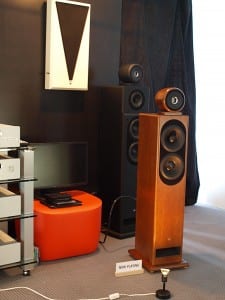 which is a real shame. The loudspeaker playing at the time was the Ofreo Supreme, a 4 ohm, 92 db loudspeaker that looks to be of a conventional transmission line design. There are two 6.5” bass/mids and a double ribbon tweeter mounted in its own head on top of the main cabinet. The sound from such a small loudspeaker is surprisingly large with excellent bass response and a great soundstage. Top end is sweet and unforced and pure. A very nice loudspeaker indeed and one I’d be happy to have in the house long term. 3 D labs, as I say, are relatively unknown in the UK but are very popular here in France and I’ve been luck enough to have owned for a short time one of their CD players. Build quality it excellent and you really should see if you can get yourself a listen.
which is a real shame. The loudspeaker playing at the time was the Ofreo Supreme, a 4 ohm, 92 db loudspeaker that looks to be of a conventional transmission line design. There are two 6.5” bass/mids and a double ribbon tweeter mounted in its own head on top of the main cabinet. The sound from such a small loudspeaker is surprisingly large with excellent bass response and a great soundstage. Top end is sweet and unforced and pure. A very nice loudspeaker indeed and one I’d be happy to have in the house long term. 3 D labs, as I say, are relatively unknown in the UK but are very popular here in France and I’ve been luck enough to have owned for a short time one of their CD players. Build quality it excellent and you really should see if you can get yourself a listen.
Gato Audio
What a great looking room! You get a settee, a table with lots of chocolates on it and a simulated fire on a flat screen TV. The only thing missing was a large glass of red wine. 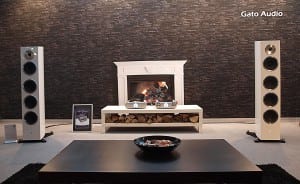
Speakers were the company’s own 2.5 way bass reflex FM- 6 ( I think) with the Amp-150 stereo integrated amplifier and CDD1 Dac and CD player.
The whole lot is very stylish looking set off by the electronics’ brushed aluminium and unique styling.
This was an easy to listen to set up which was nice, insightful with great soundstage and imaging. All in all very good and well rounded sound that I’d be happy to live with. Clearly the unique design will appeal to many for whom the aesthetic appearance of their hifi equipment is important but this shouldn’t put off those serious about the sound the kit makes too!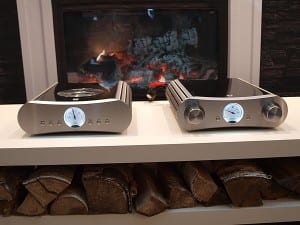
Van den Hul
This was an interesting room with the company’s Excalibur 100w power amp being fed by their Emerald balanced pre. 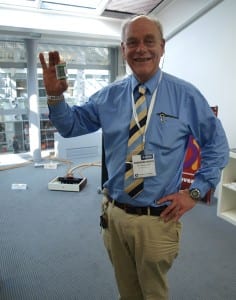 Front end was vinyl (Dr Feikert Blackbird) with one of the Van den Huls cartridges, a Grail phonostage and of course their own cables. Whilst we were in the room a recording made in a concert hall in Beijing was playing and the whole sound was very convincing indeed.
Front end was vinyl (Dr Feikert Blackbird) with one of the Van den Huls cartridges, a Grail phonostage and of course their own cables. Whilst we were in the room a recording made in a concert hall in Beijing was playing and the whole sound was very convincing indeed.
Of course van den Hul are famous for their cables and company president and CEO A.J van den Hul took us to one side to give us a sneak preview of some new technology the company are working on. The cable was in use between the phonostage and the preamplifier and was made up of 19 strands of carbon nano tubes. The individual strands of this material looked like very fine cotton and it’s a very interesting concept that I’m sure we’ll be hearing more about in the near future.
Chord
Chord Electronics displayed its brand new network music player from the midsized Choral range, the Codex at the 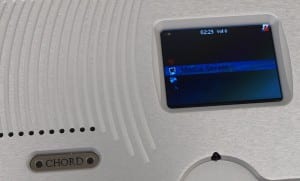 Munich High end show. The new streamer includes the key features of the flagship 24-bit/192kHz DSX 1000 and will also include DSD-over-Ethernet capability. The Codex unit has a bespoke QuteHD 384kHz DAC section, as opposed to the DSX1000’s QBD76 HDSD internals, with multiple inputs and an additional digital output.
Munich High end show. The new streamer includes the key features of the flagship 24-bit/192kHz DSX 1000 and will also include DSD-over-Ethernet capability. The Codex unit has a bespoke QuteHD 384kHz DAC section, as opposed to the DSX1000’s QBD76 HDSD internals, with multiple inputs and an additional digital output.
A top-mounted screen provides playback info and the unit also comes with a high-quality headphone output. The price is expected to be under £5,000 when it launches later in the summer.
I’ve spent a good deal of time listening to Chord electronics in the past and I’ve always enjoyed them a great deal. The room wasn’t a disappointment with a good, clean and purposeful sound. The kit also looks great in my opinion…but judge for yourself as we took lots of pictures.
We had a good chat with Colin Pratt at the show and he was obviously very proud to count amongst their customers Ray Charles and even the Wu Tang Clan.

























































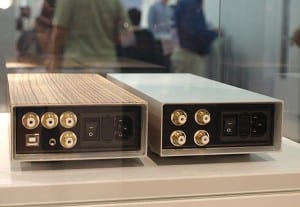





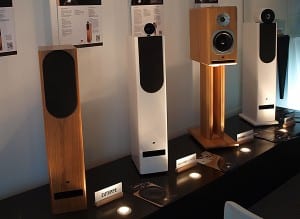
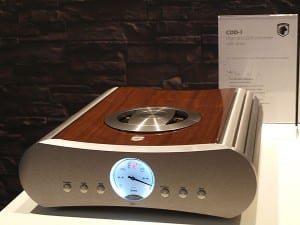
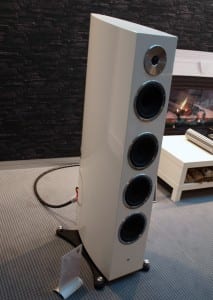
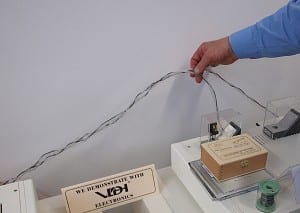

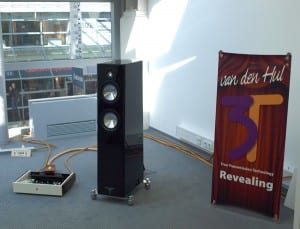
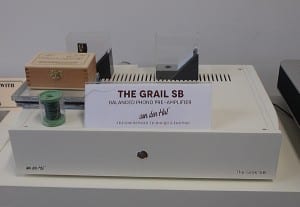
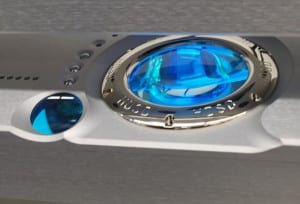

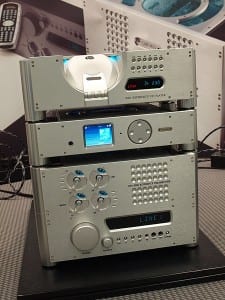
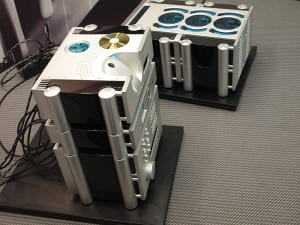
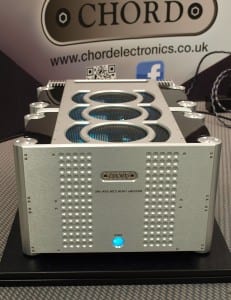



























































































































































You must be logged in to leave a reply.